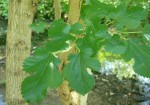The mulberry was a popular tree this spring, hosting a bevy of birds and squirrels each day in its fruit-filled branches. Gray catbirds were most numerous. Flitting quickly from perch to perch, they’d pluck and swallow berries as big as their beaks got wide. Robins fed here too.
If correctly identified, three of these trees seem like a good representation of how mulberries are distributed in the southern portion of Pennsylvania.
 Nearest the creek, one tree’s leaves are primarily lobed, feeling finely-haired on the bottom and more like sandpaper on top. Red and purple berries hang between them. These traits characterize our native red mulberry tree whose edible fruit was valuable to both Native Americans and European settlers. Bark and roots were used medicinally, fibers were good for rope and weaving, and its wood made good fence and boating material.
Nearest the creek, one tree’s leaves are primarily lobed, feeling finely-haired on the bottom and more like sandpaper on top. Red and purple berries hang between them. These traits characterize our native red mulberry tree whose edible fruit was valuable to both Native Americans and European settlers. Bark and roots were used medicinally, fibers were good for rope and weaving, and its wood made good fence and boating material.
 A little further from the creek, at the bottom of a slope, is a smoothly oval-leafed variety of mulberry. Its white unripe berries were one of the catbird’s favorites. But these berries also ripened to pink, red, and purple this spring. Unlike our native red, the white mulberry tree hails from China. Entrepreneurs brought it in the 18th and 19th centuries to feed the worms and ambitions of a silk industry that never spun a fortune. The white mulberry subsequently spread so extensively that it often outnumbers the red. Many call it a weed.
A little further from the creek, at the bottom of a slope, is a smoothly oval-leafed variety of mulberry. Its white unripe berries were one of the catbird’s favorites. But these berries also ripened to pink, red, and purple this spring. Unlike our native red, the white mulberry tree hails from China. Entrepreneurs brought it in the 18th and 19th centuries to feed the worms and ambitions of a silk industry that never spun a fortune. The white mulberry subsequently spread so extensively that it often outnumbers the red. Many call it a weed.
 The white and red trees have even hybridized, making identification particularly difficult. That brings me to the top of the hill and a mulberry with variously shaped leaves. They are not as smooth on top as the white mulberry, and not nearly as gravelly as the red. Some feel a bit hairy on the bottom. Others, not so much. Berries turn from white-pinkish to purplish-black. I’m not sure which to call it–a hybrid perhaps.
The white and red trees have even hybridized, making identification particularly difficult. That brings me to the top of the hill and a mulberry with variously shaped leaves. They are not as smooth on top as the white mulberry, and not nearly as gravelly as the red. Some feel a bit hairy on the bottom. Others, not so much. Berries turn from white-pinkish to purplish-black. I’m not sure which to call it–a hybrid perhaps.
Whatever variety, the mulberry perfectly hosted many in its branches this year. Its fruit came plentifully and has now gone the way of spring. The robins, squirrels, and catbirds are finding new spots to feed.
June 17, 2012 at 10:17 pm
When I was in third grade, I had a seat next to a window overlooking a line of mulberry trees (we used to love to eat the fallen ones during recreation but I don’t think our parents were too thrilled with the stains on our clothes.) But they soon had to move me away from the window because I couldn’t keep my eyes away from the birds gathering the berries all fall and into early winter.
June 19, 2012 at 9:05 am
Ah, yes, thanks for sharing these great memories. This spring the robins, catbirds, cardinals, and squirrels are making quick meals of the ripening mulberries here on Little Crum Creek. One tree is already nearly picked clean.
June 4, 2012 at 2:17 pm
I have fond memories of climbing a mulberry tree as a child. My girlfriend and I would sit up there eating the mulberries and bask in the sweet-ripe fragrance of the fruit. Thanks for the walk down memory lane!
June 7, 2012 at 9:02 pm
Thanks for coming by, Gloria, and sharing this sweet memory.
October 9, 2011 at 6:28 pm
Scott,
By viewing your site it is obvious you and I find great enjoyment in the natural world around us.. Great blog site! Larry Smail
October 11, 2011 at 9:30 am
True, Larry. I do indeed find a great many things I wouldn’t want to do without. Thanks for stopping by!
October 8, 2011 at 11:00 am
Very good
June 4, 2012 at 7:02 pm
Cheers.
September 28, 2011 at 2:08 pm
I’m enjoying your explorations of Little Crum Creek!
Mulberry trees are underappreciated.
September 29, 2011 at 6:57 pm
More mulberries for the rest of us, right?
Here the gray catbirds, robins, and squirrels seem to enjoy them most.
And I’ll bet they’re a refreshing find on a long bike ride.